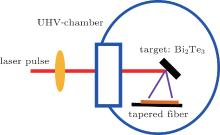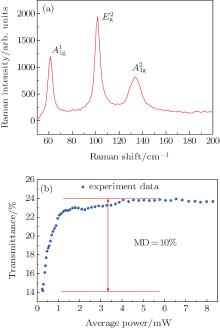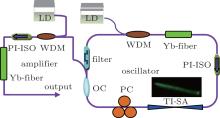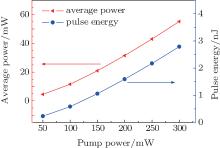†Corresponding author. E-mail: chinawygxjw@opt.ac.cn
*Project supported by the National Natural Science Foundation of China (Grant No. 61378024) and the Natural Science Fund of Guangdong Province, China (Grant No. S2013010012235).
In this study we present an all-normal-dispersion Yb-doped fiber laser passively mode-locked with topological insulator (Bi2Te3) saturable absorber. The saturable absorber device is fabricated by depositing Bi2Te3 on a tapered fiber through using pulsed laser deposition (PLD) technology, which can give rise to less non-saturable losses than most of the solution processing methods. Owing to the long interaction length, Bi2Te3 is not exposed to high optical power, which allows the saturable absorber device to work in a high power regime. The modulation depth of this kind of saturable absorber is measured to be 10%. By combining the saturable absorber device with Yb-doped fiber laser, a mode-locked pulse operating at a repetition rate of 19.8 MHz is achieved. The 3-dB spectral width and pulse duration are measured to be 1.245 nm and 317 ps, respectively.
The passively mode-locked technique with a saturable absorber (SA) is considered to be an effective way to achieve the mode-locking operation in fiber lasers.[1] In the past two decades, various types of SAs have been extensively investigated, which include the semiconductor saturable absorber mirrors (SESAMs), [2] carbon nanotubes, [3, 4] and graphene.[5, 6] Graphene-like two-dimensional materials such as MoS2 and WS2 have attracted growing interest for mode-locked fiber laser applications.[7, 8] Quite recently, topological insulators (TIs) as interesting materials have received a great deal of attention, and the characteristics of optical saturable absorption were confirmed.[9] In addition, topological insulators can be fabricated more easily by more methods than graphene or carbon nanotubes. Actually, the TIs combined with the laser cavity, used as the SA, have been demonstrated.[10– 12] TI is a state of quantum matter that has a band structure with Dirac-like linear dispersion on its surface state.[13] Several materials, such as Bi2Te3, Bi2Se3, and Sb2Te3 have been experimentally studied, and are considered to be a kind of promising SA.[14– 16]
In general, passively mode-locked fiber lasers were realized by combining the SAs between two fiber ferrules with a standard fiber connector.[17] However, there is physical contact between the SA and the fiber end, which might cause thermal damage, mechanical damage, and laser scattering. Also, thermal damage accumulation can be significant when the power in the laser increases due to the limited SA interaction in this scheme, which makes the device vulnerable to damage and difficult to control.[18] An alternative solution using evanescent field interaction[19] has been proposed to overcome these drawbacks by combining two critical merits: one is a longer nonlinear interaction length between the guided light and SAs, which improves the stability of mode-locked fiber laser, and the other is the lower evanescent wave intensity interacting with SAs, which enhances the output power. Employing tapered fibers, D-shaped fibers and fiber taper micro-channels are the most common methods. Most of the materials in evanescent field mode locking are multiple layers materials transferred from substrates, [20] which cannot match to the fiber surface in physical contact very well so that mechanical and optical problem might come into being.
In this paper, we report a new method to fabricate topological insulator Bi2Te3 for evanescent field mode locking. Bi2Te3 is deposited on a tapered fiber by a pulsed laser deposition (PLD) device.[21] The PLD is the ideal production technology for growing the Bi2Te3 because it can keep the consistent composition of the original material.[22, 23] Unlike the high temperature requirement in chemical vapor deposition, the tapered fiber is deposited under low temperature in the PLD so that the fiber is not destroyed for thermal softening. The deposited material has good contact with the tapered fiber and will not fall off. To date, the shortest pulse width of 128-fs generated from a mode-locked fiber laser by TI is operated at 1.55 μ m.[24] At the 2-μ m waveband, a pulse width of 795 fs has been achieved.[25] However, there are a few reports about mode locked fiber lasers operating near 1 μ m with TI.[26, 27] Here, the Yb-doped mode locked fiber laser is realized with a repetition rate of 19.8 MHz by using fiber-taper TI-SA Bi2Te3. The amplified single pulse energy and pulse duration are measured to be 2.8 nJ and 317 ps.
A typical setup for the PLD is schematically shown in Fig. 1. In an ultrahigh vacuum (UHV) chamber, targets are struck at an angle of 45° by a pulsed and focused laser beam. An Nd:YAG laser (λ = 1064 nm. Mode: SL II-10, Surelite) is employed in the PLD system as an ablation source with a 10-Hz repetition rate. The single pulse energy is 2 mJ and the average power of the laser is 2 W. The target is Bi2Te3 and the vacuum pressure of the chamber is fixed at 5× 10− 4 Pa during the deposition procedure. The deposition time is 90 min. Figure 2 shows the scanning electron microscope (SEM) image of the tapered fiber and the morphology of the deposited Bi2Te3. The length of taper is about 0.6 mm and the waist is about 55 μ m.
The Bi2Te3 solution is observed by a transmission electron microscope (TEM) in order to elucidate the crystalline orientations of nano-sheets as shown in Fig. 3. Figure 3(a) shows a low magnification bright field TEM image of the Bi2Te3 nano-sheets, exhibiting a hexagonal morphology. Figure 3(b) displays a high-resolution TEM image of the same nano-sheets and single crystalline quality. The circle indicates the position where a selected-area electron diffraction pattern was taken as shown in Fig. 3(c). The selected-area diffraction pattern can be indexed as a 6-fold symmetry zone axis pattern, which is in agreement with the layered structure.
 | Fig. 3. (a) TEM image of Bi2Te3 nano-sheets; (b) high-resolution TEM image of Bi2Te3 nano-sheets; (c) selected area diffraction pattern of Bi2Te3 nano-sheets. |
The measured Raman spectrum of the Bi2Te3 layer is shown in Fig. 4(a). Three typical Raman optical phonon peaks are identified as 


The Yb-doped fiber (YDF) laser including laser oscillator and laser amplifier are schematically shown in Fig. 5. The ring laser oscillator cavity is comprised of a gain fiber, a wavelength division multiplexer (WDM), a polarization-independent isolator (PI-ISO), optical coupler (OC), a polarization controller (PC), and a fiber-taper TI-SA.
A 20-cm long Yb-doped fiber (Liekki Yb 1200-4/125) with an absorption coefficient of 1200 dB/m at 976 nm is employed as a gain medium. The YDF is pumped by a 980-nm laser diode (LD). The PI-ISO is used to force the unidirectional operation in the fiber ring cavity. The PC is used to achieve different polarization states. The optical coupler is used, a 10% portion of the laser is coupled out from the oscillator cavity. Since the laser oscillator cavity in this case is all-normal dispersion, a spectral filter is essential for stable mode-locking operation. As a result, a fiber-pigtailed filter centered at 1053 nm with a bandwidth of 2 nm is inserted in the cavity to obtain mode-locking at 1-μ m wavelength. The total length of the laser oscillator cavity is about 10.5 m. The output pulse is further amplified by a YDF amplifier. A single mode fiber (SMF) pigtailed LD with a maximum output power of 700 mW is adopted as a pump source in the amplification stage, a 30-cm-long Yb-doped fiber (Liekki Yb 1200-4/125) with an absorption coefficient of 1200 dB/m at 976 nm is employed as a gain medium.
In the experiment, the Yb-doped fiber laser oscillator starts the continuous wave (CW) at a pump power of 60 mW, and the mode-locking operation is obtained at 230 mW. This mode-locking threshold is relatively high, which is mainly due to the large scatter losses caused by the fabrication process of the fiber-taper. As shown in the inset of Fig. 5, the evanescent field around the tapered fiber is easily observed by an infrared night vision viewer while the light confined into other parts of fiber core could not be seen.
As shown in Fig. 6(a), the optical spectrum of mode-locked pulses is centered at 1052.5 nm and the 3-dB spectral width is 1.245 nm. When the pump power reaches 290 mW, the mode-locking operation becomes unstable and the fluctuation of the spectrum is obvious. However, the stable mode-locking operation is observed again when the pump power decreases from 290 mW. This phenomenon indicates that TI-SA is not destroyed by the thermal accumulation. The unstable mode-locking may be interpreted as the over-saturation of TI-SA at 290 mW. The corresponding oscilloscope trace is depicted in Fig. 6(b), and the pulse trace on the oscilloscope shows a relatively uniform intensity with a pulse-to-pulse interval of 50.75 ns corresponding to the cavity roundtrip time. In order to evaluate the long term stability of mode locking, the laser oscillator works for 48 h continuously and the spectrum remains reasonably stable, which indicates the very stable mode-locking state. Since the output average power from the oscillator is only 3 mW, which is too low to be detected by an autocorrelator. The measured autocorrelation trace of the YDF amplifier is illustrated in Fig. 6(c). The full width at half maximum (FWHM) is 447 ps, which means that the pulse width is 317 ps if a Gaussian fit is used. PLD technology combined with tapered fiber improves the damage threshold of the SA, which is helpful for working at a high power regime. However, due to the fact that the tapered fiber used here is fabricated by manual manipulation and the waist of the tapered fiber is not optimized, the laser scatter loss is relatively large, which reduces the mode-locking output power. To overcome the trouble, we adopt tapered fiber fabrication equipment. Dispersion management would introduce laser losses to some extent. In further experiments, we would settle the tapered fiber fabrication issue to enhance the average output power and then optimize dispersion compensation work as shown in Refs. [29] and [30], finally realizing an ultra-short pulse output with high average power.
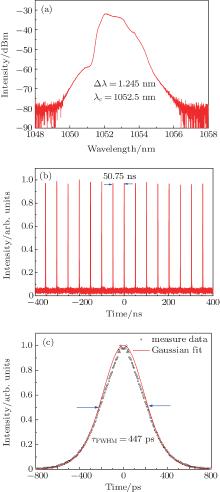 | Fig. 6. Experimental results: (a) optical spectrum, (b) oscilloscope trace, and (c) autocorrelation trace. |
In order to show the performance of laser amplifier comprehensively, we fix the pump power of the laser oscillator at 250 mW. The amplified average power and single pulse energy with respect to amplifying pump power is investigated as demonstrated in Fig. 7. The largest output power is 55 mW and the corresponding pulse energy is estimated to be 2.8 nJ. The changes of the spectral bandwidth of the amplified pulse at different pump powers are not obvious and the spectra remain stable.
In our experiment, we verify whether the mode-locking operation is purely contributed by the saturable absorption of the fiber-taper topological insulator Bi2Te3. For this purpose, the fiber-taper TI is removed out of the laser oscillator. On this condition, we cannot observe mode-locking operation despite rotating the PC and adjusting the pump power. The comparative results show that mode-locking operation is indeed contributed by the saturable absorption of the fiber-taper topological insulator Bi2Te3.
A Yb-doped mode-locked fiber laser based on evanescent field interaction with the Bi2Te3 topological insulator is demonstrated. The Bi2Te3 topological insulator deposited on tapered fiber is fabricated by the PLD method. This scheme guarantees continuous mode-locking operation by taking advantage of both the longer interaction length and saturable absorption effects. With this kind of SA, a Yb-doped mode-locked fiber laser is achieved. The amplified single pulse energy and the pulse duration are measured to be 2.8 nJ and 317 ps, respectively. The results indicate that the PLD method is a promising means for practically fabricating the SA device.
| 1 |
|
| 2 |
|
| 3 |
|
| 4 |
|
| 5 |
|
| 6 |
|
| 7 |
|
| 8 |
|
| 9 |
|
| 10 |
|
| 11 |
|
| 12 |
|
| 13 |
|
| 14 |
|
| 15 |
|
| 16 |
|
| 17 |
|
| 18 |
|
| 19 |
|
| 20 |
|
| 21 |
|
| 22 |
|
| 23 |
|
| 24 |
|
| 25 |
|
| 26 |
|
| 27 |
|
| 28 |
|
| 29 |
|
| 30 |
|



